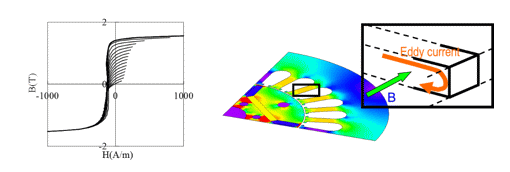Contents
1. Introduction
2. Physical Phenomena in the Steel Sheet and Reproduction by Simulation
3. Understanding Physical Phenomena in the Motor Steel Sheet Using Play Model + 1D Method
4. Conclusion
5. References
1. Introduction
Discussions so far have focused on the degree to which agreement was found with respect to total loss on actual measurements and analysis in iron loss evaluations. However, as the importance of loss evaluation technology gains recognition due to the emergence of high efficiency motors, evaluation by analysis looks at more than just total loss. It is also important to understand the mechanism of loss generation through the detailed analysis of physical phenomena occurring in the core, and now the movements that are influenced by material design can be seen. Along with this, major changes have also been introduced in analysis methods. Features include analysis techniques based on previous Epstein test results that are not dependent on the loss data, and its primary analysis technique (hereinafter the Play Model + 1D method) has been gaining attention.
Since the play model + 1D method calculates the magnetic field and eddy current field based on the magnetization and electrical properties of materials, not only the final loss result but also the detailed distribution of the magnetic field and the eddy currents that give loss results can be provided at the same time.
Within the landscape of progressing loss analysis techniques described above, the latest version of JMAG incorporates an analysis function that can confirm details of BH history, eddy currents, and loss distribution in the steel sheet.
In the following examples, detailed physical phenomena in steel sheets can be acquired by simulation through the confirmation of analysis results in JMAG’s latest analysis function of the Play Model + 1D method.

Fig. 1 Example of magnetic properties (left) used for the play model and eddy current image in steel plate (right)
2. Physical Phenomena in the Steel Sheet and Reproduction by Simulation
The magnetic and electrical phenomena occurring in the actual steel sheet are strongly correlated and are very complicated. The distribution of eddy currents in the lamination direction in the steel sheet increases in the opposite direction, across the zero in the middle of the steel sheet because of the reflux in it, it has a point symmetric distribution that peaks on the opposing steel plate surface (Fig. 2). Eddy currents also have induction fields which are a secondary field, so it greatly affects the BH history. As a result, the BH history also has distribution in the lamination direction. The decrease in magnetic permeability due to magnetic saturation leads to an increase in the skin depth, so effective electrical conductivity increases (Fig. 3). For this reason, eddy current loss increases as magnetic saturation increases even at the same frequency.
You need to sign in as a Regular JMAG Software User (paid user) or JMAG WEB MEMBER (free membership).
By registering as a JMAG WEB MEMBER, you can browse technical materials and other member-only contents for free.
If you are not registered, click the “Create an Account” button.
Create an Account Sign in



